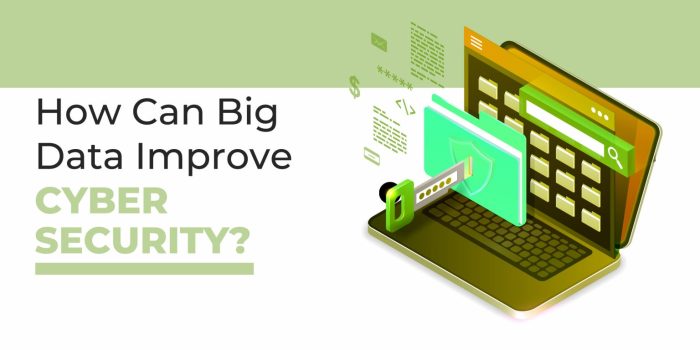How to ensure big data security and privacy is a critical concern in today’s digital landscape, where vast amounts of sensitive information are generated and processed. As organizations increasingly rely on big data to drive decision-making and enhance customer experiences, the need for robust security measures becomes paramount. This exploration delves into essential strategies, from encryption techniques to compliance standards, that safeguard data integrity and user privacy.
With the rise of sophisticated cyber threats, understanding the intricacies of data encryption, access control, anonymization strategies, and regulatory compliance is vital. This overview will guide you through the mechanisms that not only protect big data but also foster trust among users, ultimately leading to a secure data environment.
Data Encryption Techniques: How To Ensure Big Data Security And Privacy
Data encryption is a crucial aspect of big data security and privacy, serving as a primary barrier against unauthorized access and data breaches. With the exponential growth of data generation, ensuring that sensitive information remains confidential and intact is more important than ever. Various encryption methods are employed to protect big data, each with its unique features and applications.
Encryption Methods in Big Data Security, How to ensure big data security and privacy
Data encryption methods can be broadly categorized into symmetric and asymmetric encryption. Each has its distinct approach to securing information, which is essential in different scenarios.
- Symmetric Encryption: This method uses a single key for both encryption and decryption. The security of symmetric encryption relies heavily on the secrecy of the key. Common algorithms include Advanced Encryption Standard (AES) and Data Encryption Standard (DES). AES, in particular, is widely adopted due to its strength and efficiency in handling large volumes of data.
- Asymmetric Encryption: Also known as public-key cryptography, this method utilizes two keys: a public key for encryption and a private key for decryption. This approach enhances security, as the private key does not need to be shared. Notable examples include RSA (Rivest-Shamir-Adleman) and ECC (Elliptic Curve Cryptography), which are often used for secure communication and digital signatures.
The choice between symmetric and asymmetric encryption depends on the specific requirements of the data being protected. Symmetric encryption is generally faster and more efficient for large datasets, while asymmetric encryption offers greater security for key distribution and management.
Encryption Tools and Software
Numerous tools and software solutions are available for implementing encryption in big data environments. These tools facilitate the protection of sensitive information, ensuring compliance with data protection regulations and enhancing overall data security.
- VeraCrypt: An open-source disk encryption software that provides strong security. It is often used to encrypt entire drives or partitions, making it a popular choice for protecting sensitive data stored on local devices.
- BitLocker: A built-in encryption feature in Microsoft Windows that encrypts entire drives to secure data against unauthorized access. BitLocker is particularly useful in enterprise environments where data security is paramount.
- OpenSSL: A widely-used toolkit for implementing SSL and TLS protocols, OpenSSL provides an extensive library of cryptographic functions, including encryption and decryption capabilities. It is often utilized in web servers to secure data in transit.
- HashiCorp Vault: A tool designed for securely accessing secrets and protecting sensitive data. It supports various encryption methods and can manage encryption keys for different applications, making it ideal for cloud-based environments.
These tools are instrumental in ensuring data integrity and confidentiality, aligning with best practices for big data security.
The adoption of big data technology offers numerous advantages for businesses. Not only does it enhance decision-making processes, but it also allows organizations to identify trends and predict future outcomes, significantly boosting operational efficiency. To explore more about the specifics, check out the detailed insights on the benefits of using big data technology.
Access Control Mechanisms

In the realm of big data security, access control mechanisms play a vital role in safeguarding sensitive information from unauthorized access. These mechanisms help organizations manage who can view or use resources in a computing environment, ensuring that data privacy is upheld while also facilitating compliance with varying regulatory requirements.Access control is not a one-size-fits-all solution; rather, it encompasses several models that cater to different organizational needs and data sensitivity levels.
Each model offers unique features and benefits tailored to specific use cases in big data environments. Understanding these models can enhance an organization’s ability to protect its data effectively.
Types of Access Control Models
There are several predominant access control models utilized in big data environments, each with its distinct methodology for managing access rights:
- Discretionary Access Control (DAC): In this model, the owner of the data has the discretion to grant access to other users. DAC allows users to control access to their resources, often leading to flexibility but also potential security risks if not managed carefully.
- Mandatory Access Control (MAC): MAC enforces access restrictions based on data classification and user roles, often used in highly secure environments. Users cannot change access permissions, significantly mitigating risks of unauthorized access.
- Role-Based Access Control (RBAC): RBAC assigns permissions based on the roles of individual users within an organization. This model simplifies management by grouping permissions, which aligns well with organizational structures and enhances data privacy.
- Attribute-Based Access Control (ABAC): ABAC provides access based on attributes (user attributes, resource attributes, and environmental conditions) that define a user’s access rights. This model offers high granularity and flexibility, making it suitable for complex data environments.
The significance of Role-Based Access Control (RBAC) in ensuring data privacy cannot be overstated. By assigning permissions based on the role of a user, RBAC minimizes the risk of data breaches while ensuring that employees have access only to the necessary data required for their tasks. This model also simplifies the onboarding process for new employees and supports audit compliance by enabling clear visibility of who has access to what data.
Comparison of Access Control Models
Understanding the differences between Discretionary Access Control (DAC) and Mandatory Access Control (MAC) is crucial for organizations looking to implement effective data security measures. The table below highlights the key characteristics of both models:
| Feature | Discretionary Access Control (DAC) | Mandatory Access Control (MAC) |
|---|---|---|
| Control | Data owners have control over access permissions. | Access is determined by a central authority based on security classifications. |
| Flexibility | Highly flexible, allowing owners to grant access as needed. | Less flexible, with strict enforcement of access rules. |
| Security Level | Moderate; depends on user management and discretion. | High; reduces the risk of unauthorized access significantly. |
| Use Cases | Commonly used in commercial environments. | Often used in military and government organizations where data sensitivity is paramount. |
| Ease of Management | Can become complicated as user ownership increases. | Central management can simplify oversight but may require additional resources. |
Data Anonymization Strategies
Data anonymization is a critical process for organizations aiming to protect user privacy while utilizing big data for analysis and decision-making. By implementing effective anonymization strategies, businesses can mitigate the risks associated with data exposure and comply with privacy regulations without compromising the integrity of their datasets.Data anonymization techniques focus on modifying personal data in such a way that individuals cannot be identified without additional information.
Various methods exist, including data masking and pseudonymization, each with unique implications for data usability and security. Understanding these processes is essential for organizations aiming to strike a balance between data utility and privacy protection.
Methods for Anonymizing Data
Anonymization techniques can vary widely, with some methods being more suitable for certain types of data and applications than others. The following methods are commonly employed to anonymize data:
- Data Masking: This technique replaces sensitive data with fictitious data while maintaining the same format. It allows organizations to use realistic data in non-production environments without exposing actual user information. For example, a customer’s real name might be replaced by “Customer A” in test databases.
- Pseudonymization: In this approach, identifiable data is replaced with pseudonyms or artificial identifiers. Although this method does not eliminate the possibility of re-identification, it adds an additional layer of security. For instance, instead of using a Social Security Number, an organization might use a unique code that can be mapped back to the original data only by authorized personnel.
- Data Aggregation: This method involves summarizing individual data points into a collective form, effectively hiding the identities of individuals. For example, instead of reporting individual sales figures, a company might publish total sales per region, thus protecting individual customer identities.
- Noise Addition: This technique involves adding random noise to the data to obscure the true values. For example, in a dataset containing ages, slight variations can be introduced so that exact ages are not identifiable, making it difficult to ascertain individual identities.
Implications of Data Masking and Pseudonymization
Data masking and pseudonymization offer significant advantages for data privacy but also come with their own set of implications. These techniques can greatly enhance data protection, yet they must be applied judiciously to maintain data utility.
In the healthcare sector, big data is revolutionizing patient care and operational efficiency. By analyzing vast amounts of data, healthcare providers can improve diagnoses, personalize treatment plans, and enhance overall patient outcomes. For those interested in how this technology is shaping the industry, the article on big data applications in healthcare industry provides a comprehensive overview.
Data masking enhances security by protecting sensitive information while allowing for functional operations on the data.
While data masking effectively protects sensitive information, it can limit the analytical capabilities of the data. Users may find it challenging to perform certain types of analysis since the data does not reflect real values. Pseudonymization, on the other hand, can lead to the possibility of re-identification if not managed correctly. Organizations must ensure robust controls are in place to prevent unauthorized access to the mapping keys that link pseudonyms back to actual identities.
Best Practices for Implementing Data Anonymization
Implementing effective data anonymization requires careful consideration and adherence to best practices. The following guidelines can help organizations maintain a robust approach to data privacy:
- Conduct a thorough data assessment to identify which data requires anonymization and the level of sensitivity involved.
- Utilize a combination of anonymization techniques to enhance security while ensuring data remains usable for analysis.
- Regularly review and update anonymization methods in response to evolving privacy regulations and technological advancements.
- Train staff on the importance of data privacy and the specific anonymization techniques being used to ensure compliance and awareness.
- Implement strict access controls to limit who can view or manipulate anonymized data, further safeguarding against unauthorized re-identification.
Compliance and Regulatory Standards
The landscape of big data is continually evolving, and with it comes a myriad of compliance and regulatory standards that organizations must adhere to in order to protect sensitive information. Understanding these regulations is essential to not only ensure data privacy and security but also to avoid severe penalties associated with non-compliance.Key regulations significantly impacting big data security include the General Data Protection Regulation (GDPR) and the Health Insurance Portability and Accountability Act (HIPAA).
GDPR, enacted in the European Union, emphasizes the importance of personal data protection and privacy, applying to all organizations handling EU citizens’ data, irrespective of the organization’s location. HIPAA, on the other hand, specifically addresses the protection of health information in the United States, mandating stringent safeguards for electronic health data.
Key Regulations Impacting Big Data Security
Understanding the nuances of major compliance frameworks is crucial for organizations managing large datasets. The following Artikels the primary regulations and their implications:
- General Data Protection Regulation (GDPR): This regulation requires organizations to implement necessary technical and organizational measures to safeguard personal data. Key points include:
- Users must give explicit consent for data collection.
- Individuals have the right to access, modify, or delete their data.
- Organizations must appoint a Data Protection Officer (DPO) in certain cases.
- Health Insurance Portability and Accountability Act (HIPAA): Focused on the healthcare industry, HIPAA establishes privacy and security provisions for protected health information (PHI), with major requirements including:
- Implementation of administrative, physical, and technical safeguards.
- Regular audits and risk assessments to identify vulnerabilities.
- Mandatory reporting of data breaches affecting PHI.
- California Consumer Privacy Act (CCPA): As a landmark state-level legislation, CCPA enhances privacy rights for California residents, with key features such as:
- Consumers can request details about the personal data collected by businesses.
- Right to opt-out of the sale of personal data.
- Businesses must provide clear privacy policies outlining data usage.
Compliance Frameworks Relevant to Big Data
Organizations are encouraged to adopt comprehensive compliance frameworks that encompass various regulatory requirements. Some prominent frameworks include:
- NIST Cybersecurity Framework: This voluntary framework provides guidelines on managing cybersecurity risk, emphasizing a risk-based approach tailored to organizational needs.
- ISO/IEC 27001: An international standard for information security management systems (ISMS), ensuring that organizations systematically manage sensitive information.
- COBIT: The Control Objectives for Information and Related Technologies (COBIT) framework assists enterprises in achieving their governance and management objectives related to data security.
Penalties for Non-compliance and Risk Mitigation
The consequences of failing to comply with established regulations can be severe, ranging from hefty fines to reputational damage. For instance, GDPR violations can lead to penalties up to €20 million or 4% of global revenue, whichever is higher. Similarly, HIPAA violations may incur fines ranging from $100 to $50,000 per violation, depending on the level of negligence.To mitigate risks associated with non-compliance, organizations should adopt proactive measures such as:
- Regular training programs for employees on data protection practices.
- Conducting periodic audits to assess compliance with regulatory requirements.
- Implementing robust data governance policies to guide data management practices.
- Utilizing advanced technologies for real-time monitoring and reporting of data breaches.
Proactive compliance management not only safeguards organizations against penalties but also fosters trust with customers and stakeholders.
Monitoring and Incident Response

In the realm of big data, ensuring security is as critical as the data itself. As organizations continue to amass vast amounts of data, the risk of security breaches grows exponentially. Effective monitoring and swift incident response are key components of a robust security framework. This section delves into strategies for monitoring big data environments for potential breaches, the necessity of having a well-defined incident response plan, and Artikels the steps to undertake when a data breach occurs.
Strategies for Monitoring Big Data Environments
Continuous monitoring of big data environments is essential to identify and mitigate security threats effectively. Implementing a series of strategies can help organizations safeguard their data.
- Real-Time Analytics: Utilizing advanced analytics tools that offer real-time insights into data activity. This allows for immediate detection of anomalies or suspicious behavior.
- Automated Alerts: Setting up automated alerts for unusual access patterns, failed login attempts, and unauthorized data changes helps in prompt detection of potential breaches.
- Network Traffic Analysis: Monitoring network traffic for unusual spikes or patterns can indicate unauthorized access attempts or data exfiltration.
- Integration of AI and Machine Learning: Leveraging AI can enhance predictive capabilities, allowing systems to learn from past breaches and adapt their monitoring strategies accordingly.
Importance of an Incident Response Plan
Having a well-defined incident response plan is crucial for minimizing damage during a security breach. An incident response plan Artikels the steps to take when a breach occurs, ensuring that organizations respond quickly and effectively.
“A well-crafted incident response plan allows organizations to mitigate damage, recover quickly, and protect their reputation.”
Key aspects of an incident response plan include:
- Preparation: Establishing a dedicated response team and providing them with the necessary training and resources.
- Identification: Quickly identifying the nature and extent of the breach to formulate an appropriate response strategy.
- Containment: Taking immediate steps to contain the breach and prevent further unauthorized access to data.
- Eradication: Removing the root cause of the breach from the environment to prevent recurrence.
- Recovery: Restoring affected systems and data to normal operations, ensuring all vulnerabilities have been addressed.
- Lessons Learned: Conducting a post-incident review to identify what went wrong and how to improve future responses.
Steps in the Event of a Data Breach
Understanding the steps to take in the event of a data breach is vital for effective incident management. The following flowchart Artikels the critical actions to be taken:
Detection and Identification
- Confirm the breach and assess the impact.
- Containment
- Isolate affected systems to prevent further data loss.
- Eradication
- Identify and eliminate the cause of the breach.
- Recovery
- Restore data and systems from backups; monitor for any signs of weakness.
- Notification
- Inform stakeholders and regulatory bodies as required by law.
- Review and Adaptation
Analyze the incident and update the response plan accordingly.
This structured approach to incident response not only aids in addressing the immediate consequences of a breach but also strengthens future resilience against potential threats.


